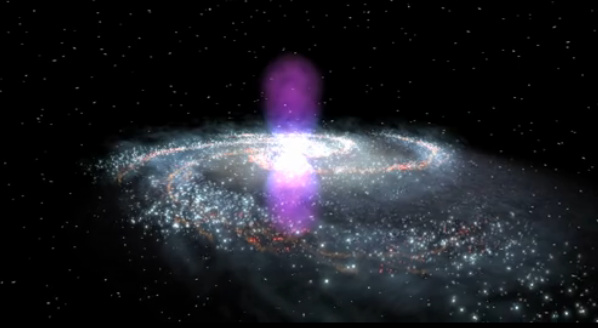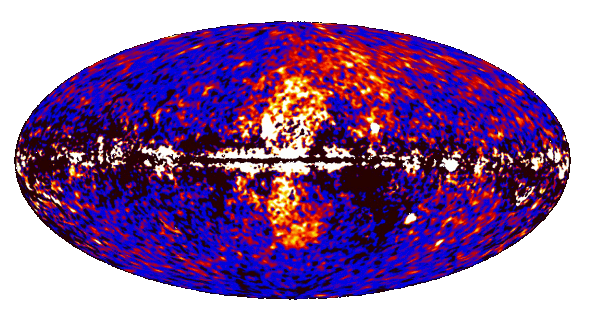Cosmic Ice and Galactic Flatulence
November 16, 2010
Hans Hörbiger was an Austrian engineer who was lucky enough to strike it rich with one of his inventions, a
type of valve that's used even today. As happens with technically-minded people with sufficient leisure time, his mind started to wander into speculation on the nature and origin of the
universe. Believing that the brightness of the
moon was due to
ice, he developed his
Cosmic Ice Theory (Welteislehre) in which our
Solar System was formed by the impact of a dead, waterlogged star into the
Sun. The explosion of this impact hurled water into space, and this water solidified into blocks of ice.
Hörbiger's theory had great predictive power, at least in 1894 when
astronomy was still emerging from just an observational to a true scientific discipline (It wasn't until that 1920s that it became apparent that the universe was larger in extent than our
Milky Way Galaxy). According to his theory, the Milky Way is just a ring of ice blocks. The larger planets are large because they incorporated a greater number of ice blocks than the smaller planets.
Meteorology goes back to it's roots in his theory, since
meteors are blocks of ice, and their effect can be seen in the production of
hailstorms.
Sunspots are formed when ice blocks fall into the Sun. Hörbiger didn't have just ice on his mind. A vision came to him in a dream that
Newton's law of universal gravitation was wrong. He was certain that "the sun's gravitational pull ceases to exist at three times the distance of
Neptune."[1] Hörbiger's theory wasn't received well in scientific circles, but the public liked it, probably because it was easy to understand and was based on "
common sense." Needless to say, modern astronomy has disproved all aspects of the Cosmic Ice Theory.
Now, there's a new item to capture the public imagination. It appears that our galaxy expelled a galactic
fart several million years ago. Although
methane has been detected in space, this is not that type of flatulence. It's composed of
gamma rays, it was unexpected, and its nature and origin are unknown.[2-10] It was discovered by
astronomers from the
Harvard-Smithsonian Center for Astrophysics using data from
NASA's Fermi Gamma Ray Space Telescope.[2] These data were from Fermi's Large Area Telescope, the most sensitive and highest-resolution gamma-ray detector in space. This gamma ray feature had gone unnoticed, since it was buried in a background fog of gamma emissions, and only advanced
signal processing techniques were able to reveal it. Douglas P. Finkbeiner, principal author of the article in
The Astrophysical Journal that announced the discovery,[2] said that data from other spacecraft, such as the
Roentgen X-ray Satellite (ROSAT) and NASA's
Wilkinson Microwave Anisotropy Probe (WMAP), also show traces of this feature.[3]

Artist's conception of the gamma ray bubbles. (NASA image).
The feature, as illustrated in the figure, is composed of two gamma ray emitting bubbles that shoot in opposite directions from the Milky Way's center. These bubbles are huge, extending 25,000
light years from the center in each direction, and the astronomer's best guess is that these are remnants of an eruption of the
supermassive black hole at the center of the galaxy. These bubbles have a sharp edge, which would indicate that the energetic event that caused them was extremely rapid. Since the speed of light is a limiting constraint, the eruption event must have occurred quite some time ago. There are features of the galactic center that suggest that a special event occurred there a few million years ago, and this might explain the bubbles. Whatever the cause, the energy content is equivalent to about about 100,000
supernovae.[5]
Although pretty pictures, like the artist's representation above, are nice to see, there's something special about raw data, as shown below. The figure shows intensity data from 1 to 10 GeV after processing.

Fermi gamma ray data. (NASA/DOE/Fermi LAT/D. Finkbeiner, et al.)
References:
- Willy Ley, "Watchers of the Skies: An Informal History of Astronomy from Babylon to the Space Age," (Viking Press, 1966). p. 515, as cited by Wikipedia.
- Meng Su, Tracy R. Slatyer and Douglas P. Finkbeiner, "Giant Gamma-Ray Bubbles From Fermi-Lat: Active Galactic Nucleus Activity Or Bipolar Galactic Wind?" The Astrophysical Journal, vol. 724, no. 2, p. 1044ff.
- David A. Aguilar and Christine Pulliam, "Astronomers Find Giant, Previously Unseen Structure in our Galaxy," Harvard-Smithsonian Center for Astrophysics, Press Release No. 2010-22, November 9, 2010.
- Trent Perrotto and Lynn Chandler, "NASA's Fermi Telescope Finds Giant Structure in our Galaxy," NASA Press Release, November 9, 2010.
- Thomas H. Maugh II, "Huge gamma-ray bubbles found extending from Milky Way," LA Times, November 10, 2010.
- NASA unveils giant gamma ray bubbles cap galaxy, USA Today, November 9, 2010.
- Adam Mann, "Fermi spies giant galactic bubbles," Nature Blog, November 9, 2010.
- Video: Fermi discovers giant bubbles in Milky Way, NASA.
- Astronomers find giant, previously unseen structure in our galaxy, Science Blog, November 9, 2010.
- Dave Mosher, "Galactic Core Spews Weird Radiation Bubbles," Wired Science, November 9, 2010.
Permanent Link to this article
Linked Keywords: Hans Hörbiger; valve; universe; moon; ice; Cosmic Ice Theory; Solar System; Sun; astronomy; Milky Way Galaxy; meteorology; meteors; hailstorms; sunspots; Newton; law of universal gravitation; Neptune; common sense; fart; methane; gamma rays; astronomers; Harvard-Smithsonian Center for Astrophysics; NASA; Fermi Gamma Ray Space Telescope; signal processing; The Astrophysical Journal; Roentgen X-ray Satellite (ROSAT); Wilkinson Microwave Anisotropy Probe (WMAP); light year; supermassive black hole; supernova.